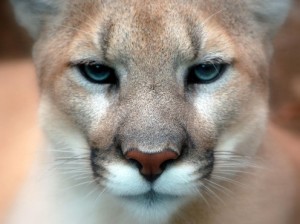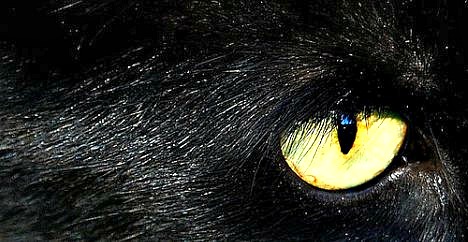A firefly (Photuris lucicrescens) or “lightning bug” is a crepuscular beetle
June 2013
Cat lovers love their cats, but let’s be honest: Not all cat lovers know cat facts. Here’s one common misconception about house cats:
Myth: Cats are nocturnal.
Fact: The domestic house cat (Felis silvestris catus) is actually crepuscular, which means they are most active at dusk and dawn. Most indoor cats follow a very specific trend of dawn and dusk activity, rather than strictly at night.
Crepuscular behavior is also one of the reasons why cats wake us up every morning at the Same. Darn. Time.

Crepuscular Critters!
Crepuscular animals are species that are active primarily during twilight (at dawn and dusk). They tend to sleep at night and lay low during midday, when the sun is at its peak, reserving their energy when it’s hottest. The word crepuscular is derived from the Latin crepusculum, meaning “twilight”. Crepuscular behavior differs from diurnal and nocturnal behavior, which respectively peak during hours of daylight and darkness. However, crepuscular critters can also be active on a bright moonlit night, or on an overcast day. Some animals that are casually described as nocturnal are actually crepuscular. There are subdivisions of crepuscular animals. Matutinal animals are most active in the morning, while vespertine animals are most active at dusk.

I hesitate to state that every house cat is crepuscular, but most indoor cats do fall under the crepuscular category. However, it’s important to note that companion cats have adapted to our schedules so that each individual cat, whether a stray alley cat or pampered house cat, can change their activity level at will, choosing to become less nocturnal or more diurnal in response to their environment or the routine of their humans.
The time of day when cats are most active may not be all hard-wired genetically, but may vary according to their lifestyle, which is greatly influenced by the human in their house. This was revealed in a scientific study. The results showed that there was a “high influence of human presence, and human care on the amount of activity in cats”. This means that many companion cats will adapt their activity levels according to how they are cared for by their person, and the routines that the person has in their home. It seems that many house cats are more “in sync” with their people than previously believed!
Feral cats’ daily activity patterns—sleeping during the day and being active at night, which likely reflects the behavior of their prey, lets them better avoid humans—was very different from kitties with homes. Those animals were most active in the morning and evening, when their owners were likely home and awake. ~ The Secret Lives of Feral Cats

Fast Feline Fact: Most cats will sleep up to 16 hours a day, and older cats will sleep as much as 20 hours a day! These sleeping times vary in individual cats and in each home, but most sleep is during the daytime. When cats are most active is dependent on the home environment and how in sync they are with the sun, or their human’s schedule.
Secretive Kitties or Careful Cats?
Some people live with felines that hide away all day in their secretive, quiet spots in the house while the humans or other animals are awake and moving about. If this is the case, then chances are your Secretive Kitties will creep out at night when the coast is clear. One of my feline companions, Samantha, loved to explore the house when the people and the annoying Kitty Boys were asleep. She would wait until the house was “sleeping”, then romp around, playing with toys and jumping about when she thought no one was watching. She loved to explore every nook and cranny of the house when she knew it was safe. The prime real-estate window that was claimed during the day became her throne at night.

Samantha and the kitty boys are much like the average cat that sleeps between 12 and 20 hours every day, but they had very different schedules that fit their feline needs. While this varies from cat to cat, most of a cat’s sleep takes place during the daytime. This daytime hiding and sleeping behavior tends to make humans believe that cats are nocturnal. If we rarely see them during the day and then see them come out at night when they are most comfortable, we assume they are nocturnal. However, true nocturnal animals hunt, forage, eat, bathe, etc. at night.
Nocturnality is an animal behavior characterized by activity during the night and sleeping during the day. The common adjective is “nocturnal”. Nocturnal animals are more active at night than during the day. These animals sleep during the day, often in a burrow or den. Many animals, like desert animals, are nocturnal in order to escape extreme daytime heat.

Older Cats and Outdoor Cats
Outdoor cats tend to display more nocturnal behaviors, due to their natural hunting instinct and their ability to follow through on this powerful innate need to hunt, capture, and kill prey. Scientists believe that nighttime is when cats’ prey is most active outdoors. Therefore hunting is best at this time. This behavior stems from their lineage as desert cats, where nighttime temperatures were cooler, and prey was more available.

Younger cats tend to stay up at night, because they instinctively know that this is “prime hunting time”. But as cats grow older, they will adapt to the sleeping patterns of their home environment. Eventually these cats will become more crepuscular.
I have seen this happen with our two older male cats. They sleep most of the day, are very active early in the morning (dawn), very active at dusk, but sleep again when the rest of the humans (and dog) are asleep at night. Our youngest cat stays up later than the older boys, but he does eventually come to bed after he is done exploring the quiet house.

Fun Feline Sight Facts:
Cats’ night time vision is far superior to that of humans, however they can’t see in total darkness. The structure of a cat ’s eye allows them to see well in low light. Cats only need 1/6 of the light humans do in order to decipher shapes. The muscles of the cat’s iris surrounding the pupils are constructed to allow the eye to narrow to a vertical slit in bright light and to open fully in very dim light, to allow maximum illumination. These special feline features developed for survival purposes, as wild cats are nocturnal and do much of their hunting at night.

A reflective layer behind the cat’s retina called the tapetum lucidum reflects incoming light and bounces it back off the cones, making more use of the existing light. The tapetum is what we see in action when light hits a cat’s eyes at night, you see shiny green orbs.
Felis silvestris catus Sundials
Cats are such great examples of sundials. They naturally define their life by the sun. Most cats who are in sync with the sun’s movement will be active at dawn and dusk. This is because it’s part of their natural feline biology. It’s instinctive! I encourage you to be a Conscious Companion and start to observe how your cat moves with the sun around the house throughout the day. See if your cat is more in sync with your human schedule, or with the sun’s movement.
Does your feline fit in the crepuscular category, or do they hideaway during the day and release their inner wildcat at night? Share in the comment section below!
Interested in learning more about your feline family member? Check out our Feline Educational Resources!
Looking for support to assist you with your feline companion? Conscious Companion is here to help! Learn more here.
ConsciousCompanion.com




Pingback: Stimulate Them! | Conscious Companion
Pingback: Riddle-Speak | Raishimi33
Our kitty Mina is certainly crepuscular. She does much of her sleeping at night, but she didn’t do much as a baby. Nowadays she’s up right around sunrise, zipping around with what we refer to as “the rips” 🙂
Thanks for this great article.
LikeLiked by 2 people
Oh my gosh i thought they were nocturnal all my life wow I’m glad I read this.
LikeLiked by 1 person
Most people believe cats are nocturnal. Glad you found the article helpful!
🙂 Blessings
LikeLiked by 1 person
Are snakes generally, nocturnal?
LikeLiked by 1 person
Hey, Okon! It depends on the species; many are active during the day and many are active at night.
LikeLiked by 1 person
I just love the word crepuscular. The way it flows out of your mouth and hitches on your tongue… Great post, Amy: chock full of interesting facts!
LikeLiked by 1 person
My two year old devon rex sleeps next to me throughout the night. During the day she naps near me, but is quick to wake up whenever I am doing anything that she is curious about. She follows me around the house and loves to watch me clean. She is an excellent companion.
LikeLiked by 1 person
Corrin, what a lovely feline family member! Aren’t they wonderful? 🙂
LikeLiked by 1 person
Reblogged this on momentarylapseofsanity.
LikeLiked by 2 people
Pingback: Is your cat nocturnal? | newsfirstsite
Interesting article now I know my cat is not nocturnal she is precuscular
LikeLiked by 1 person
Pingback: 7 Purrsistent Cat Myths that We Really Should Know By Meow | Viral Kollective
I hate to day i was feeding to stray cats and they would be at my door at dusk and dawn but they also ate small animals my two house cats seem crespuculer but one was a stray kitten and likes to go out on a harness to explore at night.usually 3am.
LikeLiked by 1 person
Pingback: Why Do Cats Play With Their Prey? | Sweetie Kitty - 2017
Pingback: 46 Surprising Cat Fact That'll Make You Say "Wow" - Real Pet News
Pingback: 46 Surprising Cat Fact That'll Make You Say "Wow" – zoompress
Pingback: 46 Surprising Cat Facts That’ll Make You Say “Wow” | Dogs and Cats
Pingback: Ultrafacts: Crepuscular Behavior Is Also One Of The Reasons Why… | JustaFact
Funny, my 12 year old just told me last night that cats were nocturnal. I didn’t know. We have a 9 week old baby we had to bottle feed at 3 weeks. Now he starts what I call spazzing every morning and evening…it’s funny. He was so calm at first. She said you should hear him at night.! He sleeps in her room. I can’t sleep, tonight, walked into the hall and heard all kinds of scurrying and things coming from her room, I see what she means!! I don’t know how she sleeps with that kitten in her room! But, we love him…
LikeLiked by 1 person
Pingback: Covert Cougars! – Conscious Companion
Pingback: Benevolent Beings – Conscious Companion
Pingback: KRuthie73
Pingback: Cats Who Cache! – Conscious Companion
2 1/2 year old Louis is a bengal who is nuts at twilight. Running from window to window to get the most fresh air. He’ll cry and meow like crazy until someone pays attention. Loves it when I bring out the cat carrier in the evening and we go for a walk-about in the yard or down the street. Seems to want to get sprayed with the water bottle, and then settles down purring and wanting some ‘rough’ pats. I’ve only had dogs my entire life, but this little character is unlike any other pet I’ve ever had. Lyla, his sister, is another little dickens who will get into a bunch of mischief as well. They seem to take turns driving us koo-koo.
LikeLike
Cats can definitely drive us nuts! But there is *always* a reason for their behaviors. Cats are such a very unique species; truly unlike dogs in their DNA. We don’t understand what they need as a species, until we understand them as a species. We have a ton of free resources on our website about cats’ environmental, emotional, and biological needs. There’s so much that cats are lacking in homes. You’re welcome to check it out:
LikeLike
Pingback: 101 Amazing Cat Facts: Fun Trivia About Your Feline Friend - Uluckysob
Pingback: How Long do Cats Sleep? 8 Things Owners Need to Know I Discerning Cat
Pingback: Your are the best - Sendva
Pingback: It's Mine - Sendva
Pingback: Natural massage - Sendva
Pingback: Why Do Cats Sleep So Much? - Cat and Craft Co blog
Pingback: 101 Amazing Cat Facts: Fun Trivia About Your Feline Friend – Petmate
Pingback: Facts ~ Facts about Cats - Daily Random Facts
Pingback: 8 Surprising Facts About Our Feline Friends - Petsmartgo
Pingback: Fun amazing facts about cats. – Catchy.Queen